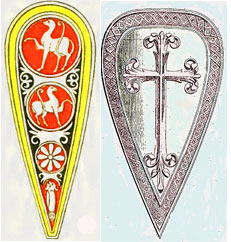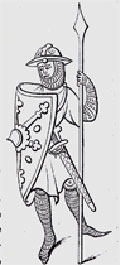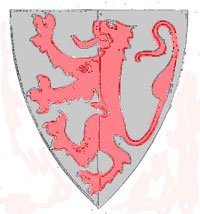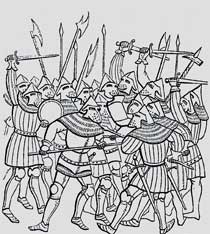Medieval Shields Designs
In England, the Medieval shields construction was heavily influenced by the Norman conquest.
Medieval Kite shieldThe so-called kite shield had mainly a flat design, as depicted in the Bayeux tapestry. The soldiers are shown using their shields as trays on which to set the cups and dishes. Sometimes, the shield was bowed, and might also have a projecting spike, as in the Great Seal of King Stephen. Generally, this was the favorite form until the end of the 12th century.

Kite Shields

Triangular Bowed Shield
The design of the Medieval shields will be diversified about the middle of the 12th Century, when the triangular shield was introduced. The new form was obtained by reducing the arched top of the kite to an almost straight line. This variety of Medieval shields was also bowed or flat. And, though the earliest examples were as tall as the kite shields, the triangular design soon adopted a much reduced height. The kite and triangular shields were provided with straps for attachment to the arm and for suspension round the neck.
Once we enter the 13th Century, the majority of the designs in use were based on the triangular Medieval shield. Notably, the dimensions of the triangular shield of this period are decreasing as the century advanced. The triangular design could be of two shapes: bowed or flat.
The round shield is of more rare appearance. It appears that it was more frequently by the foot troops.
Other formats of the period were using slightly modified old designs like the kite shaped, or more advanced ones: the heart-shaped, the round, and the quadrangular. The boss is still retained in some of the shields models. The materials used for shields' construction were wood, leather, and paint for identification.

Triangular Shield
Medieval shields ornamentation
The 14th Century is the period of the most sophisticated examples of shields, offering diversity of form, material and ornament. The principal designs of the period are the triangular, the kite shaped, heart-shaped, the circular, and the notched. The triangular shield can be flat or bowed. The usual materials were wood, steel, and leather, the latter frequently embossed, and exhibiting the heralding bearings of the knight.
The previously popular kite shield and the heart-shaped shields are of rare occurrence. The curved shield appears in the second half of the century, sometimes notched, sometimes plain. The round Medieval shield was designed to be born on the arm, or to be held at arm's length. The enarmes, or straps by which the shield was attached to the arm, were placed either horizontally or vertically. The shield was suspended round the neck by a strap.
The surface of the shield is variously embellished, usually displaying the coat-of-arms of the knight's house.

Three-Planes Shield
The new "quartered" shields appeared, and, in England, the first instance might be considered that of the third great seal of Edward III. The armorial shield was occasionally enriched by diapering or filigree-work. The little shield fixed on the lance shaft to protect the hand first appears during this period.
In the 15th Century, the triangular shield, richly decorated with the knight's coat-of-arms, is a familiar presence. The round shields of this period are of two kinds: the buckler, borne in the hand, and the larger one, born on the arm.
A novelty among the Medieval shields designs is represented by the three-planes shield, mainly a piece of the equipment of the foot troops. The three-planes shield borne by the man-at-arms in the centre of the "mêlée" illustrated on the right is characteristic of this period.
